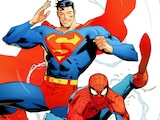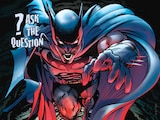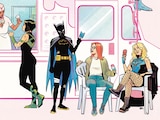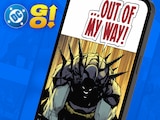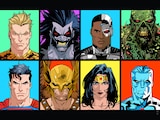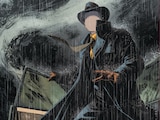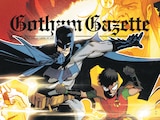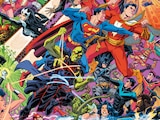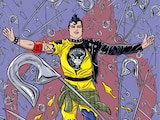Happy Holidays, DC fans! This is Alex Jaffe, known to our lively DC Community as HubCityQuestion. Every month, I bring you a sack full of solutions to the mysteries of the DC cosmos. That layabout Santa may only work one night a year, but I’m out constantly delivering the gift of knowledge. Let’s see who’s made the Nice List.
Resurrection Patrol

Wrightline1.42741 asks:
How did the Doom Patrol survive getting nuked at the end of their first title run?
Four members of the Doom Patrol were “killed” at the end of the original Doom Patrol run in 1968’s Doom Patrol #121, sacrificing their lives for the fourteen fishermen of Codsville, and all four came back in different ways. Robotman’s brain survived the explosion in its metal casing, and Will Magnus designed a new body for him. Negative Man survived as his negative spirit, tying himself to Valentina Vostok—the Negative Woman—until he could reinhabit a cloned body of his original self.
Niles Caulder, as it happened, never actually died, and instead used his presumed death as a cover to go into hiding from his enemies. In Paul Kupperberg’s Doom Patrol, it was discovered that the Chief had a personal force field emitter embedded in his wheelchair that saved him at the last moment. (And in Grant Morrison’s later Doom Patrol, it was discovered why he didn’t use it to save the whole team.)
As for Rita Farr, she was good and dead for a long, long time—38 years, to be precise. (Beating Jason Todd by over two decades!) The original Elasti-Girl would not return until the continuity-warping damage inflicted upon the timeline by Superboy-Prime during Infinite Crisis.
Easy, Breezy, Beautiful

winmurray13.74768 asks:
I know Tweedledee and Tweedledum were on multiple Golden Age covers. Crazy Quilt was on two or three. None of them really transitioned to being big “cover-worthy” modern villains. Were there other multiple-cover 1940s DC villains that just kind of died out like that, in terms of headline usage from the 1990s through today?
Quite a few. In the 1940s, you get a few familiar cover faces we still see regularly as villains today—villains like Luthor, Mxyzptlk, Joker, Penguin, Catwoman, Two-Face, Riddler, Cheetah, Vandal Savage and Solomon Grundy. But there are a few that may surprise you, and some more you might not have even heard of.
By far the most frequently featured Superman cover villain of the Golden Age, outstripping even Luthor, was Oswald Loomis, the Prankster—appearing on Action Comics #51, #57, #69, #77, #95, #104, #109, and Superman #37.

Coming in just after Prankster, over in Green Lantern, is Alan Scott’s nemesis turned eventual love interest, Harlequin, with seven cover appearances. For a couple years, Harlequin dominated the Green Lantern titles the same way Batman titles have more recently featured…well, Harley Quinn.
(Incidentally, did you know there’s never been a story where Harlequin has met Harley Quinn? Feels like an oversight at this point.)
The very first villain to be featured on multiple DC covers, before even the likes of Lex Luthor, Joker, or the Penguin, is actually Dr. Weerd, original nemesis of the Star-Spangled Kid and Stripesy, on Star-Spangled Comics #1, #2 and #5.
After that, we have some more obscure characters who sneaked into a couple ’40s cover shots. Along with Grundy and Savage, there’s your regular JSA villains Brain Wave, Fiddler, Gambler, Icicle, Sportsmaster, Wizard and Per Degaton, who are always game for an All-Star Comics team-up, if not a couple rounds with Flash or Green Lantern.

In addition to his original A-Listers, Batman was contending with the Cavalier on Detective Comics #81 and #89, while Robin cleaned the Clock in his own solo feature making the cover of Star-Spangled Comics #70 and #74.
One of the first villains to rack up two covers is, believe it or not, a Hawkman villain, and a rather obscure one—a straw-hatted, checker-suited criminal mastermind by the name of Simple Simon, featured on Flash Comics #53 and #65.
Wonder Woman had her own recurring coterie of mostly forgotten villains in the Marston years who haven’t quite enjoyed the same celebrity as other rogues. Hypnota, Queen Clea, Countess Draska Nishki and Blakfu, King of the Mole Men, all got two cover appearances in Marston’s tenure.

In addition to Luthor, Mxy and the once-popular Prankster, Superman featured Toyman on the cover of Action Comics #64 and Superman #44, as well as the much lesser-known J. Wilbur Wolfingham on Action Comics #79 and #116, a con man who would show up to bilk the citizens of Metropolis out of their money until Superman could expose him as a fraud each time.
Finally, one curious case is that of the inept gangsters Winky, Blinky and Noddy, originally featured on All-Flash #5. Although they were introduced as incompetent villains, the three quickly took up the roles of Jay Garrick’s hapless supporting cast, pulling comic relief duty frequently on Golden Age Flash covers thereafter.
Peace on Earth-One

Cradle2theGabe asks:
What has been Gotham’s longest stretch of peace? Obviously, crime and violence always happens in Gotham, but I’m talking about the really devastating events. Anything that was or could be classified as a “war.” Mass killings, I suppose, would also qualify, as well as natural disasters like No Man’s Land.
Honestly, Gabe, I’d say the entire stretch of 1939 to 1985. There was never really a city-wide “crisis” the way they happen in Gotham regularly today until the skies went red in Crisis on Infinite Earths. Most Pre-Crisis comics were fairly self-contained, and rarely, if ever, shifted the balance into catastrophe for a prolonged period. Stories were all wrapped up and the hero always won the day before “nothing could be the same ever again.” Truly a different world.
Big Girls Don’t Cry

MiscellaneousSoup asks:
I have a hard time with the concept of Black Canary being a singer. Was it used in the comics before the pre-DC Rebirth “Batgirl of Burnside” era? I primarily associate it with that one.
You’re more or less correct there. Black Canary as a singer is something that was first incorporated into canon with 2015’s Batgirl #38, four issues into Barbara Gordon’s “Batgirl of Burnside” period. In fact, the pre-Flashpoint Birds of Prey comics used to have a recurring joke that Dinah was actually a pretty lousy singer, despite her canary cry.
However, it’s not the first place we see her that way! Prior to 2015, Black Canary was previously heard singing in two episodes of the animated series Batman: The Brave and the Bold, utilizing the vocal talents of Grey DeLisle in “Mayhem of the Music Meister!” and “The Mask of Matches Malone!” Black Canary was also reinterpreted as a wartime songstress for the DC Bombshells statue line, about a year before her canonical rock band debut.
Some Ho-Ho-History

RexRebel asks:
What was the first Christmas celebration involving our favorite heroes?
The tradition of the Christmas Holiday Special goes back to the very first December that National Comics was in business. 1935’s New Comics #2 features a story called “$5,000 Reward!” where our hero, Dickie Duck, an anthropomorphic duck, saves Christmas by apprehending a ring of bank robbers so he can use the reward money to afford Christmas presents.
Christmas would remain a feature on National’s comic covers every year, but our first Christmas special involving some connection to the DC Universe as we know it today was in 1939’s All-American Comics #10-11, a two-part story called “Christmas in the Country” featuring Scribbly Jibbet—and, more importantly, his aunt Ma Hunkel, who would later become the first Red Tornado. By 1941’s All-American Comics #36, Scribbly would be celebrating Christmas with Ma once again in her Red Tornado persona.
In 1940, National published its very first dedicated Christmas special, featuring their most popular character: Superman’s Christmas Adventure #1, where our Champion of the Oppressed meets Santa Claus for the first time.

1941 gave us our first Batman and Robin Christmas in Batman #9. By 1942, we had Wonder Woman celebrating Christmas in Sensation Comics #14, Mary Marvel in Fawcett’s Wow Comics #9, Wesley Dodds, the Golden Age Sandman, in Adventure Comics #82, and the cover of Comic Cavalcade #5 would give us our first Christmas-themed superhero team-up as a promotional comic book cover: Wonder Woman, Green Lantern and the Flash all gathered around the jolly figure of Santa. (As was typical for anthologies of the time, no such story occurred in the issue itself.)
1944’s Comic Cavalcade #9 featured the first Green Lantern Christmas story, where Alan Scott battles against bigotry with a powerful message that the holidays are for everyone. 1945’s All-Flash #21 brought Christmas cheer to National’s own red-suited globetrotter, Jay Garrick. In 1949, DC began publishing Rudolph the Red-Nosed Reindeer, an annual comic featuring new adventures of the holiday icon through 1961. 1971’s Collectors’ Edition #C-34, “Christmas with the Superheroes,” would be DC’s first reprint anthology of previously published superhero Christmas stories.

Comic cover photo ops aside, DC’s very first team-up of superheroes celebrating Christmas together was 1967’s Teen Titans #13, “The TT’s Swingin’ Christmas Carol.” Their senior counterparts wouldn’t follow suit until 1974’s Justice League of America #110, “The Man Who Murdered Santa Claus.”
1978’s Green Lantern/Green Arrow #113 gave us a Christmas dinner with Hal Jordan, Oliver Queen and Dinah Lance, and 1980’s DC Special Series #21, “Super-Star Holiday Special,” would be DC’s first anthology of original superhero holiday stories—a regular staple from DC in recent years.
1992 would perhaps be the most notable year to date for DC holiday specials—giving us the Christmas-set Batman Returns, the animated debut of Mark Hamill’s Clown Prince of Crime in Batman: The Animated Series’ “Christmas with the Joker” and the now infamous Lobo Paramilitary Christmas Special…and I’ll cut myself off there, because this is rapidly becoming a list of my favorite Christmas specials, and that’s a different question entirely. (Read Batman: Noël, though, if you haven’t done that.)
That’s all the time we have this month, but our monthly tete-a-tetes shall return in 2024. Until then, you can always find me on the message boards. ‘Tis never not the season to ASK…THE QUESTION!
Alex Jaffe is the author of our monthly "Ask the Question" column and writes about TV, movies, comics and superhero history for DC.com. Follow him on Bluesky at @AlexJaffe and find him in the DC Community as HubCityQuestion.
NOTE: The views and opinions expressed in this feature are solely those of Alex Jaffe and do not necessarily reflect those of DC Entertainment or Warner Bros., nor should they be read as confirmation or denial of future DC plans.



